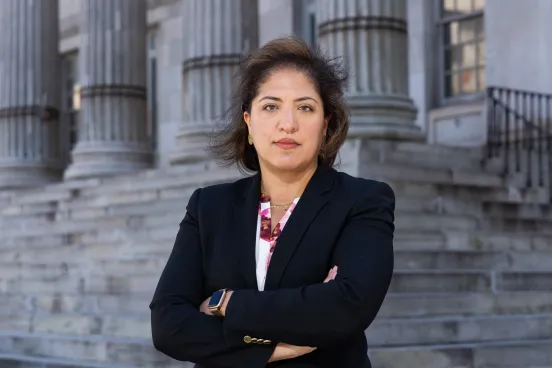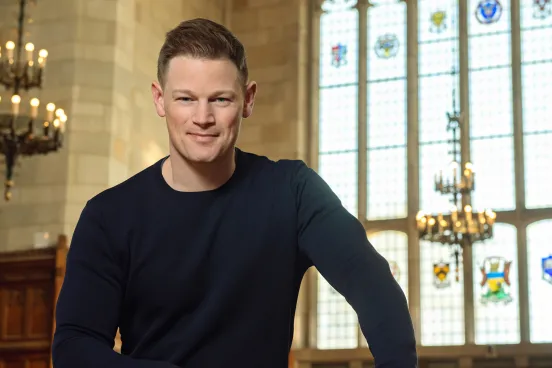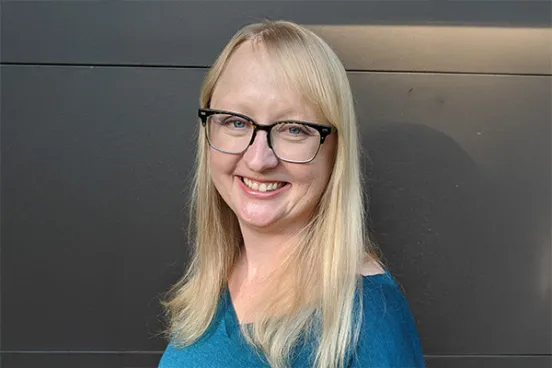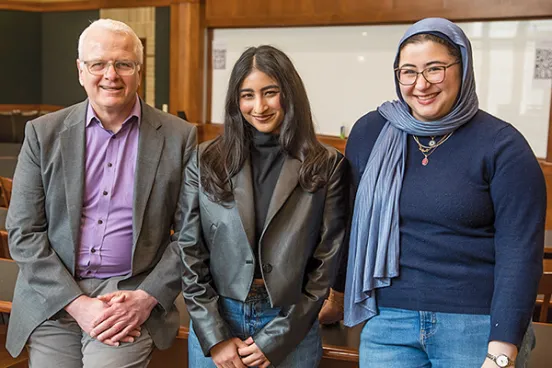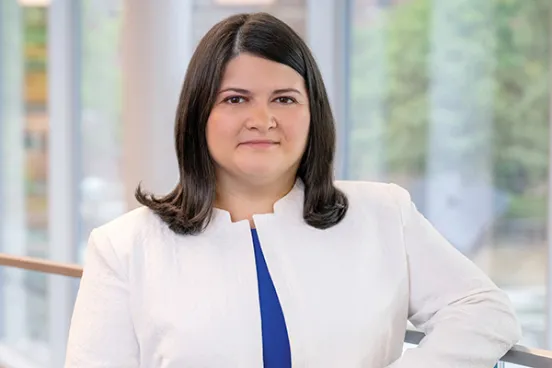In the early 1980s, environmental law was still an emerging field—environmentalism was continuing to become more prominent in the national discourse, and landmark legislation in the 1970s had provided new legal avenues for environmental advocacy. Michigan Law was established as a leader in related teaching and scholarship thanks to the groundbreaking work of Professor Joseph Sax, who taught at the Law School for 20 years beginning in 1966.
In January 1983, a group of Michigan Law students enrolled in a new practical course in the area of environmental law. The instructor was Mark Van Putten, ’82, who had joined the National Wildlife Federation (NWF) the previous summer to establish a Great Lakes regional office in Ann Arbor and to partner with Michigan Law to open an environmental law clinic.
Forty years and hundreds of students later, what is now known as the Environmental Law and Sustainability Clinic is led by NWF attorney and Adjunct Clinical Professor of Law Oday Salim. While it has evolved and expanded, it continues to provide invaluable hands-on learning experience for students, using litigation and other means of advocacy to advance environmental priorities in the Great Lakes region and beyond.
Protecting a critical watershed
Much of the clinic’s work in the early years related to the Clean Water Act (CWA), which became law in 1972. The law primarily dealt with more typical, visible pollutants—untreated wastewater making its way into the water supply, for example. But by the early 1980s, the Environmental Protection Agency (EPA) and states were developing specific limits on toxic substances like dioxins for the first time—limits which, Van Putten and others would argue, didn’t adequately protect the Great Lakes watershed.
“Because of long residence times and bioaccumulation in the lakes, the Great Lakes are particularly sensitive to the impact of toxic pollutants,” he says. “So a lot of our litigation and advocacy was around ways in which nationwide guidelines weren’t good enough for the Great Lakes.”
Strategic advocacy
The clinic’s early efforts were often in the administrative context, such as challenging a specific discharge permit for not upholding its terms or for violating state or federal law. These actions were primarily used against the EPA, as well as Great Lakes states, under the citizen suit provisions of the CWA, Clean Air Act, and the Toxic Substances Control Act. And while this approach remains a key tool in environmental advocacy—today’s students continue to work on similar matters—the work can also be understood as an avenue to influence broader change at the agency level and in Congress.
“We relatively quickly went from enforcement against individual discharges to the underlying regulations and pressing for those through a set of lawsuits, which ended in a significant settlement where the EPA agreed to convene the states to come up with consistent pollution controls,” Van Putten says.
The result of that effort was the Great Lakes Critical Programs Act—a 1990 amendment to the Clean Water Act—which included multiple provisions directly related to the clinic’s advocacy, such as comprehensive guidelines for 29 pollutants and enshrining into US law certain elements of a water quality treaty with Canada. Providing students with the opportunity to work on specific matters within a wider context has been an important part of the clinic throughout its history.
“Students weren’t experiencing litigation in isolation, but rather as one element in a broader advocacy strategy that involved administrative agencies and legislation,” Van Putten says. “The Great Lakes office of NWF became a key player with Congress, and that’s where being part of a national organization with 50 years of credibility on Capitol Hill was so beneficial.”
For Sanne Knudsen, ’02, the Stimson Bullitt Endowed Professor of Environmental Law at the University of Washington School of Law, her work as a student-attorney shaped her understanding of how law and policy intersect, both in private practice and in academia.
“I was able to work on complex litigation that involved a coalition of environmental groups, and we were strategically working on a pattern of cases to motivate the EPA to act in an area it had been neglecting related to nonpoint source pollution,” says Knudsen. “It’s an experience I still talk to my students about today in terms of how you can use the law to put issues on an agency’s agenda.”
An evolving focus
In 1996, Neil Kagan became director of the clinic when Van Putten left Ann Arbor to lead the NWF in Washington, DC. Kagan, who joined the clinic with experience bringing a number of environmental actions against state and federal agencies in Oregon, was eager to continue the clinic’s work to influence policy on a wide range of issues, including toxic pollution, nutrient pollution, invasive species, oil pollution, and water diversions.
“We would take cases in the hopes of setting precedent that would alter state and federal policy, and we commented many times on proposed federal rules, including those from the Pipeline and Hazardous Materials Safety Administration” says Kagan, who served as director of the clinic for 21 years. “This became a big priority after the disastrous oil spill in the Kalamazoo River Basin in 2010. We began spending a lot of time suing the federal government to better regulate, and in fact stop, the flow of oil through Line 5 across the Straits of Mackinac.”
Ally Beasley, ’19, came to the clinic with a background in public health and was interested in exploring its overlap with environmental justice. As a student-attorney, she mostly assisted on matters related to Line 5, “which I always saw as inexorably tied to environmental justice issues,” she says. “I spent a lot of my time working through the intricacies of the arguments being prepared for district court. It was also a really cool opportunity to do some of the procedural work you don’t necessarily get in the classroom.”
Beasley went on to land her “dream job” as a staff attorney at the Western Environmental Law Center after graduating. She says the clinic helped her understand how to apply her public health background within the legal infrastructure related to her current work, which is around greenhouse gas emissions and climate change and the cumulative health impacts of hazardous air pollutants.
A diverse area of law
One of the great benefits of the clinic is its cross-sectoral nature, which broadens the appeal of the clinic beyond those specifically interested in the climate and related issues.
“There are aspects of environmental law that are tort law, contract law, insurance law, corporate and transactional law, administrative law—it’s a great discipline to learn in,” says Salim, who became the clinic’s director in 2018. “While many clinics represent individuals, we get to represent organizations with varied missions and areas of focus, which means that our students are exposed to diverse topics and get to engage with subject matter experts of all stripes.”
The clinic has long been involved with issues around environmental justice, including successful efforts in the 1980s to modify standards related to human exposure to toxic substances in fish. (The original guidelines did not consider subsistence anglers who consume more fish than average; in Michigan, these communities are predominantly Native Americans and people of color.) That work was an early example of the environmental movement’s increasing emphasis on equity and justice. The trend continues, and today’s clinic is more explicitly focused on these issues as part of its overall advocacy strategy.
“Environmental justice law recognizes that communities who are disproportionately impacted by pollution and natural resources management are probably also disproportionately impacted in other ways,” says Salim. “This framework demands that lawyers tackle multifaceted problems with multifaceted solutions by thinking beyond traditional environmental law and also working in housing, transportation, insurance, property, agriculture, and utility law—all of which our students work on.”
Lasting impact
The clinic’s legacy is one of effecting significant, meaningful change, and its ongoing value to the environmental movement is a testament to the generations of students and faculty who have played a role.
“When I first started, my naive perspective was that the answer to many environmental problems was to sue the polluters or the agencies and force them to do what they should do,” says Van Putten. “I think Oday and the current team represent the realization that the solutions that endure are solutions that a variety of interests have a stake in. It’s a move away from the more confrontational model of earlier eras to one where business and other stakeholders have become more open to outside advocacy from groups like our clinic.”



